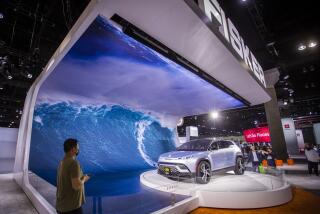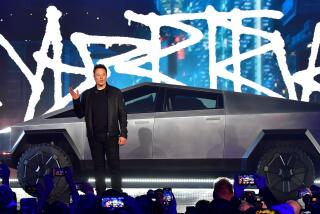Wagonerâs mileage at GM
As Rick Wagoner rides off to whatever biz-school sinecure heâs destined for, his nine years at the helm of General Motors Corp. will be evaluated in many ways and by many hands.
And yet, fairly or not, auto company chief executives are best remembered for the cars produced during their tenure. People still refer to the Cadillac Cimarron as a âRoger Smithâ car, and the Ford Mustang will somehow always belong eternally to Lee Iacocca.
The four vehicles offered here are emblematic of Wagonerâs time and leadership, of challenges met and opportunities missed.
They will forever be Wagoner cars.
General Motors EV1
Wagoner has said the biggest mistake he ever made as chief executive was killing the EV1, GMâs revolutionary electric car, and failing to direct more resources to hybrid gas-electric research. This admission is acutely painful for green-car advocates who know GM squandered its early lead in electric-hybrid technology.
The EV1 began in the 1990s as a response to a zero-emission vehicle mandate by Californiaâs Air Resources Board. GM built about 2,500 EV1s in 1996-99 and leased them to consumers in California and Arizona.
When, finally, GM and other automakers managed to get California to soften its zero-emission mandate in 2002, Wagoner promptly canceled the program. GM ordered the cars confiscated and destroyed.
From an accountantâs point of view -- and Wagoner was, first of all, a counter of beans -- the decision was correct. The cars cost far more than GM could sell them for, and maintaining a service infrastructure for the exotic cars was also expensive. Then there was the potential liability; there were reported cases of the batteries overheating.
But from a public relations perspective, the decision to haul off and crush the cars was an unmitigated disaster. EV1 advocates picketed outside GMâs West Coast offices in Thousand Oaks, spammed the automaker with angry e-mails and ranted on TV news programs.
The crowning blow was the release of Chris Paineâs 2006 documentary âWho Killed the Electric Car?â The film alleged there was a grand conspiracy among the oil companies, the government and the car companies. The EV1 saga was thus a failure of both style and substance.
Hummer H2
It is too easy to say that the Hummer H2, a civilian riff on the militaryâs âHMMWVâ (High-Mobility Multipurpose Wheeled Vehicle, or Humvee), is an example of everything that was indictable and wrong about GM: an oversized, guzzling Goliath; a blundering bully of the road; rude and reactionary.
The 6,614-pound, 6-foot-8 monster provoked howls of protest from environmentalists when it debuted in 2002.
âIt was just so over the top,â said Michael Marsden, an auto culture historian at St. Norbert College in De Pere, Wis., in an interview last year. âIt had excess written all over it, the SUV times 10. Everything about it suggested not practical, not reasonable. It was consumerism at its peak.â
Wagoner wasnât exactly wrong in signing off on the Hummer H2 (built under contract by AM General at a factory in Indiana). In fact, the vehicle was a cult hit and became a totem of wheel-spinning bling excess, favored by pro athletes, hip-hop stars and other auto extroverts. The Hummer brand instantly became one of the strongest in the GM portfolio.
And yet, those sales -- which peaked in 2003 at about 35,000 -- later cost GM dearly in terms of public perception. The company had provided an easy target, a made-to-order villain in the national debate about fuel economy, war for oil, and global warming. When fuel prices began to climb last year, Hummerâs fragile mystique collapsed, as did sales. Hummer H2 sales in 2008 totaled 6,095 units.
Hummerâs fall also reflects another error in Wagonerâs product strategy: Too much of GMâs profits relied on large trucks and SUVs, which made the company highly vulnerable to volatility in fuel prices.
GM announced last year that, as part of its reorganization plan, it would sell Hummer. Wagoner had another failed brand on his record.
Chevy Malibu
One of the great frustrations for GM partisans has been the fact that cars built by subsidiaries overseas were often better than the ones designed and built for the North American market.
Wagoner, with a strong push from GM product czar and Vice Chairman Robert Lutz, helped change that. The 2008 Malibu is the result. Built on GMâs global Epsilon platform -- engineered by Opel and shared with the Saturn Aura and Pontiac G6 -- the current-generation Malibu is a fine car, with up-to-date engineering, suave and artful styling and good quality.
Among other critical acclaim, the Malibu won the 2008 North American Car of the Year award at the Detroit auto show (in a review in this paper I called the Malibu âa fine-drawn and harmonious design, pretty but chastened with Teutonic seriousnessâ).
The Malibu has been a fairly steady seller. With GMâs total sales off 49%, Malibu sales are off 23% for the first two months of this year compared with the same period in 2008 -- better than arch rivals Honda Accord and Toyota Camry. Even so, with 2008 sales totaling 177,089, the German-engineered Malibu has not come close to threatening those competitors. The Accordâs 2008 sales totaled 372,789, and the Camry chalked up 436,617 sales.
Chevy Volt
A large part of Wagonerâs legacy has yet to be written and will depend on the outcome of the highly anticipated Chevy Volt. A range-extended electric sedan -- using a small gasoline engine to charge the batteries that drive electric motors -- the Volt has redeemed GM in the eyes of many environmentalists.
On a memorable evening in November, the Volt was the guest of honor at a party at director Chris Paineâs house in Santa Monica. Paine had vilified GM in âWho Killed the Electric Car?â
With all the chaos and downsizing at GM, Wagoner and Lutz remained committed to bringing the Volt to market by late 2010. It seems likely that GM brass does not want to relive the miseries of the EV1 episode. And yet, the Volt cannot hope to restore GM to profitability.
In fact, as noted in the governmentâs auto task force report on GMâs viability, the Volt is âlikely to be too expensive to be commercially successful in the short-term.â
Even so, the Volt is a dramatic advance in the technology of the automobile, a fundamentally different way to look at transportation. Whether Wagoner supported the Volt program purely for PR purposes or out of some awakened sense of corporate conscience, it deserves a measure of our respect. And so does he.
--






